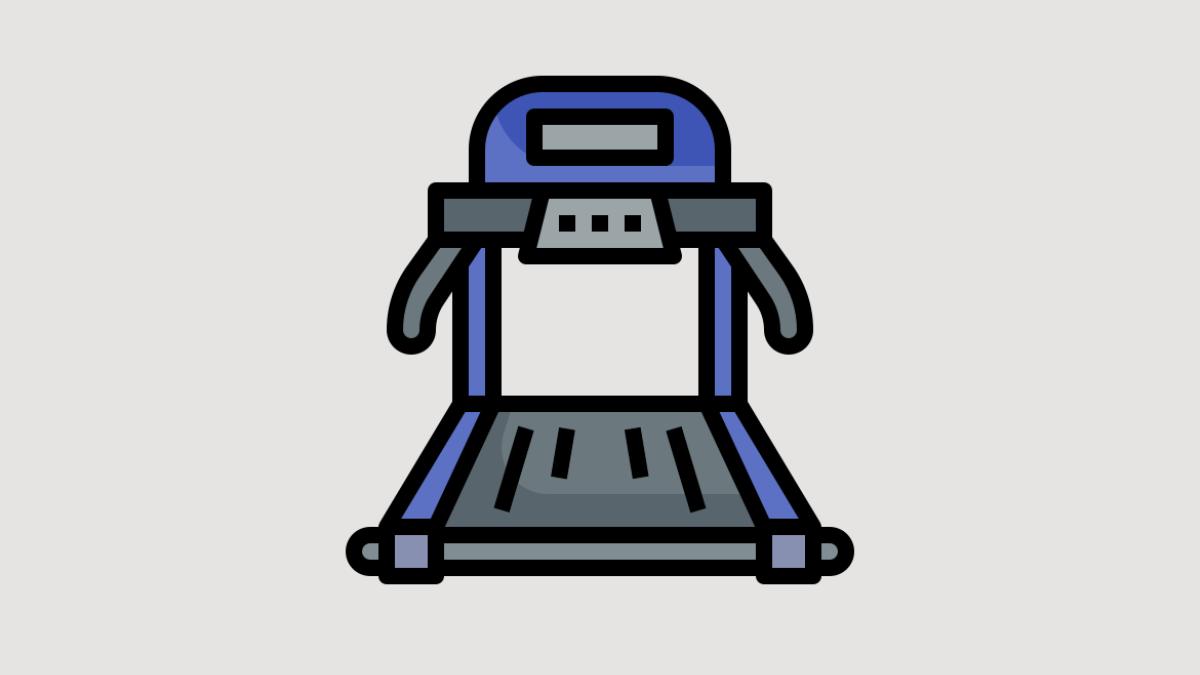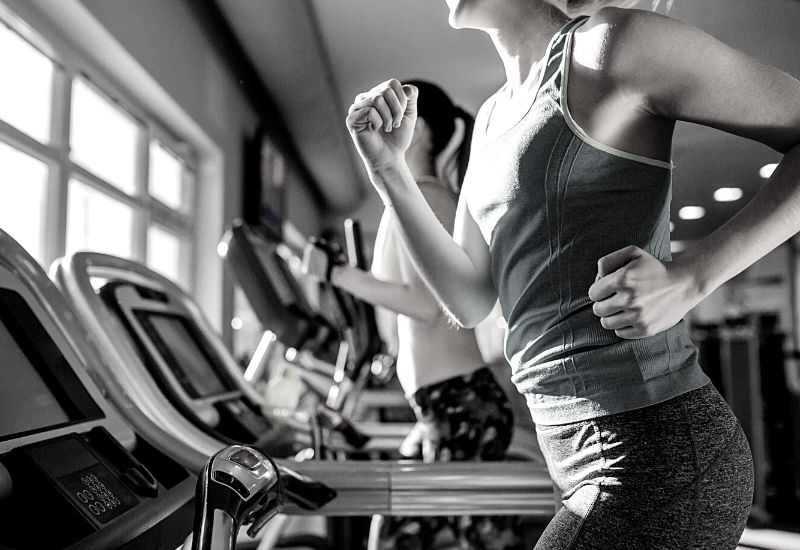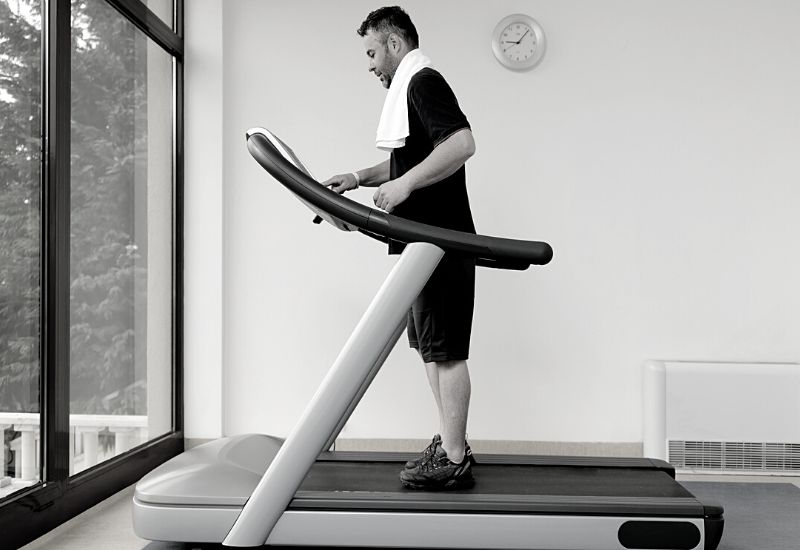Wondering if your bad knees and a treadmill are a good match? In this guide to treadmills and knee pain, we look at why the treadmill is a good option for you and list some tips for avoiding knee pain when using the treadmill.

Ask anyone with knee problems, and they’ll have more than a few horror stories about which cardio machines and cardio workouts led to the greatest number of knee injuries or pains.
Really, for every one of us with knee problems (and I count myself among that number), there is a cardio machine that we tend to avoid because of the way it impacts our joints.
So it’s no surprise that people might wonder if training on the treadmill can be bad for your knees. After all, treadmill running is a high-impact workout, and it’s well known that high-impact workouts can be hard on knee joints.
Below, we’re going to focus on how the treadmill benefits people with bad knees, and how it can actually lead to significant improvements in your knee health if used correctly.
Of course, that means we also need to talk about how to run properly on a treadmill so you protect your knees from injury while training.
By the end of this post, you’ll know exactly why the treadmill is a great choice for your knees, and what to do to avoid knee pain.
Let’s get started!

Benefits of Treadmills for People with Bad Knees
The treadmill is a great choice for people with bad knees for a few reasons.
They include:
Benefit #1: Improves Your Balance
Running on a treadmill is actually quite different from running outdoors.
When you run outside, you’re focused entirely on moving forward. Your weight is leaning slightly forward and shifting from foot to foot without much tilt to either side. As long as you place your feet squarely, your balance should never suffer when running on level terrain.
However, when you run, your foot never strikes in exactly the same way. There are minute shifts in your muscles and joints that cause you to step slightly wider or narrower every time you place your foot. Outdoors, there is space enough that it’s not an issue. On the treadmill, though, you have to stay in the center of a fairly narrow platform.
What this means is that your muscles, joints, and bones have to adapt to the specific running form needed to learn on a treadmill. Your body actually gains greater control over each step it takes, to make sure that you land squarely in the center of the treadmill platform. Over time, your control over your lower body improves, and this in turn translates to better balance overall.
Running is already excellent for your balance, but treadmill running specifically is an excellent way to counteract balance issues that may develop as you age.
And, as you probably guessed, proper posture and balance are crucial for preventing knee pain.
Benefit #2: Strengthens Your Leg Muscles
There is no doubt about it: running is great for your leg muscles.
Running engages your quadriceps muscles, and works your hamstrings, glutes, calves, foot muscles, and the muscles along your shins. These muscles all play a crucial role in quite literally every movement you make when walking, running, cycling, hiking, and doing pretty much everything else in your day.
Plus, these muscles all work together to support your knees. The muscles in your upper and lower legs are both connected to the bones around your knee joint. Strong leg muscles make the joint more resilient and are better-able to support your body weight as you run.
Fun Fact: Studies1 have shown that treadmill machines are easier on the joints compared to outdoor running, making them an excellent option for runners looking to strengthen their musculoskeletal system.
When your muscles can’t support your weight (or they tire out quickly), the bones and joints compensate. You literally end up resting the excess weight on your skeletal system, which in turn places a lot of pressure on the joints and can lead to joint pain or injury.
Strengthening the muscles around the knee is one of the most straightforward solutions to combatting joint pain, and treadmills are a great way to do it without placing extra stress on the joints.
Benefit #3: Builds New Joint and Bone Tissue
One of the best treadmill workout benefits is the fact that it strengthens your joints and bones in the long term.
Why do I say “in the long term”?
Well, here’s the thing…
Running is a high-impact exercise. What that means is that when you place your foot down with every step, there is impact (vibrations) that run up your skeletal system. The greater the impact, the more “damage” there is to your bones and the joint tissues that cushion them.
In the short-term, this damage can lead to inflammation, pain, stiffness, and reduced mobility. That’s why you might feel achy, tired, and sore after a run.
However, your body responds to the presence of this damage by making repairs. It not only builds back what was damaged, but it adds new bone and joint tissue to prevent damage in the future.
Fun Fact: There is a perception that running increases knee pain. But studies have shown that running and walking regularly reduces body fat, improves strength, and improves proprioception, helping to actually reduce long-term knee pain and damage2.
Over time, your bones and joints will become stronger as a result. High-impact exercise is the best form of exercise for strengthening your skeletal system and making it more resilient against damage.
That is why people who regularly engage in high-impact exercise tend to have stronger bones, joints, and muscle tissue than those who only perform low-impact exercise.
This may not seem very important when you’re young, but it becomes critical as you age.
With age, your body has a harder time repairing bone and joint damage. There are also less nutrients available to make those repairs. This can lead to problems like osteoporosis, brittle and easily broken bones, as well as stiff and inflexible joints—which, of course, includes your knee joints.
Benefit #4: Burns Excess Body Fat
One thing all types of treadmill workouts have in common is that they are great at burning calories, as well as fats.
Trainer’s Note: The human body has two energy sources available, glucose (blood sugar) and fats. Glucose is by far the easiest source of energy to burn, so your body typically relies heavily on this form of energy when doing exercise. However, when doing prolonged low-intensity exercise (such as a treadmill run), your body is forced to activate stored fats3 in order to maintain energy availability over the course of your workout.
The more you train in cardio (and resistance training), the more fat you burn.
Fat, unlike muscle, doesn’t contribute to your movement. It’s simply stored as a means of maintaining energy supply through periods of food scarcity. However, given our modern society, food scarcity is rarely an issue for us. We simply keep adding to our fat stores—unless, of course, we make a concerted effort to burn them.
Well, that’s what treadmill running does!
Cardiovascular exercise like treadmill running eliminates that stored fat—and can actually prevent the body from storing more fat (when paired with a proper diet).
With every pound of fat you burn, there is one less pound weighing on your hips, ankles, and, of course, your knees.

How to Avoid Knee Pain When Using a Treadmill Machine
Alrighty. Now that we have all the benefits of using a treadmill, let’s get into how to use it most effectively to avoid knee pain while using it.
Tip 1: Lower the Incline
While there are a lot of treadmill incline benefits, it’s important to know that working out at an incline will increase the strain on your knees.
Your knees bend farther when working on an incline, which means there is more pressure placed on the lower quadriceps muscles directly around the knee joint. There is greater risk of strain and inflammation on your knees because of this.
If you feel knee pain when working on an incline treadmill, keep the incline between 1 and 5%. Don’t go above that 5% mark until you’ve trained for a few weeks at this incline to strengthen the lower quadriceps muscles specifically.
Tip 2: Don’t Hold the Handrails
Having handrails to lean on is important for your safety, but you should never actually lean on them while working out.
You want the handrails close enough that you can grab them if you’re ever losing your balance.
However, holding the handrails while you walk, jog, or run will negatively impact your posture. It will cause you to lean forward and shorten your stride, both of which will contribute to higher risk of knee pain.
Tip 3: Shorten Your Run
If your knees protest when treadmill running, consider shortening your workouts.
Remember that treadmill running is a high-impact, repetitive exercise. What this means is that not only will there be impact on your knee joints with every step, but you will be repeating the same movement over and over again, essentially compounding the impact over the duration of your run.
Try knocking a mile or 10 minutes off your current runtime. If that doesn’t help to alleviate the knee pain, shorten your workout more and more until you’re no longer feeling pain afterward.
You can always work your way back up to your original workout time gradually. Just do it slowly enough that your knees have time to recover, as well as adapt to the strain of a sustained run.
Tip 4: Lower Your Speed
Sometimes, the culprit behind your knee pain could be your speed, not the duration of your run.
Running too fast can increase the strain on your joints. As you run at a high speed for longer periods, your muscles will fatigue and begin to rely more heavily on your bones and joints for support.
Try slowing down your speed by 0.5 mph. Or slow down more if you think you need it.
Running at a slower pace will help you to focus on your posture, stride, balance, and the smoothness of your movements. You may find that there are issues with your running form that you didn’t realize, which may be contributing to knee pain.
Tip 5: Warm Up and Cool Down
Last, but perhaps most importantly of all, take the time to warm up before and cool down after every workout.
One of the biggest mistakes you can make—and one of the greatest contributors to knee pain when treadmill running—is starting “cold”. What this means is jumping on the treadmill without giving your joints a proper stretch and your muscles sufficient time to warm up.
Stiff, inflexible joint and muscle tissue is more likely to be strained or damaged by your workout.
Taking even just 5 to 10 minutes to stretch and warm up beforehand will loosen up muscles that have likely grown tight over the course of your sedentary day, enabling them to move more efficiently as you run.
Cooling down after your run is equally important. It enables your body to purge lactic acid from your muscles and increases blood flow to your joints, which in turn speeds up recovery times and decreases post-workout inflammation.
FAQs
What other cardio machines are good for people with bad knees?
Outside of the treadmill machine, the best cardio machines for people with bad knees include the rowing machine, elliptical machine, and stationary bike.
All three of these machines are excellent because they reduce the strain on your knee joints and encourage more natural movement while maintaining a high-intensity energy burn nearly on par with a good run.
How long should I exercise on a treadmill if I have bad knees?
As mentioned above, your knee pain may be caused by a run that is too long. Try starting out with just 20 to 30 minutes of treadmill running.
If you can get through that full workout with no pain, add 5 to 10 minutes. Continue adding 5 to 10 minutes as desired until you begin to experience minor knee pain following your workout.
Pairing running with walking is also an excellent way to extend your workout—and the calories burned—without placing extra stress on your joints.
That will tell you how much effort your body is capable of sustaining without excessively damaging the knee joints.
The Bottom Line
Running is one of the best forms of exercise you can do for your knees. Because of its high-impact nature, it will actually strengthen your leg muscles and the bones and joints in your knees. It will also make them more resilient and better able to repair themselves.
However, it’s important to remember that running too fast, for too long, and with the wrong posture can be major contributing factors to knee pain.
Use the tips above to help you maximize the efficiency of every treadmill workout so you can enjoy your runs without feeling the pain!
More Treadmill Guides and Articles
9 Benefits of Treadmill Walking (and How Long You Should Do It). Walking on a treadmill is one of the best ways to lose weight, burn fat, and improve overall health. Here are nine benefits of treadmill walking and how long you should do it for optimal results.
Manual vs. Motorized Treadmills: Which is Best for Your Goals? Wondering whether a manual or motorized treadmill is best for you? Below, we highlight the differences between the two so that you can choose the right treadmill for your running goals.